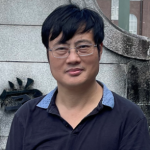〔Visiting Professor Report〕 Professor Xueyi Wang, Auburn University
Updated: 2022/11/29
Report on “Simulation study of whistler-mode chorus generation process in the Earth’s inner magnetosphere”
Prof. Xueyi Wang (Auburn University, USA)
 Whistler-mode chorus waves play an important role to control electron dynamics in the Earth’s radiation belt, and they lead to electron acceleration and precipitation losses into the atmosphere. Decades of observational, theoretical, and modeling studies on chorus waves have led to significant advances in the understanding of their excitation mechanisms. However, most of the existing studies assume a one-dimensional field-aligned wave propagation. Physics of the chorus wave excitation and evolution in the dipole field geometry still remains a challenging problem. The oblique propagation will be subject to wave attenuation at higher latitudes and introduce additional harmonic resonances. With our GCPIC model that runs at RISH supercomputer and NAS, we have conducted simulations of two-dimensional chorus waves excited by hot anisotropic electrons interacting with an L-dependence (~L-4) cold dense plasma in a dipole magnetic field. It is found that the rising tone element of chorus waves with frequency chirping from low frequency to up to higher than the half electron gyro-frequency is generated at low latitudes where the chorus wave phase speed is much less than its group velocity. As the chorus wave propagates toward high latitudes, the wave becomes oblique, and its phase speed increases while its group velocity decreases. Eventually the wave group velocity and the phase velocity become equal near the half the cyclotron frequency, in which the Landau and cyclotron resonance become significant. Two bands, i.e., upper and lower bands of chorus waves are thus formed. In addition, we have found that a strong wave-particle interaction process is present in the time evolution of chorus wave sub-packets as shown in Figure 1. Both electron hole and hill coexist in the electron phase space, and they give rise to zig-zag frequency chirping between the wave sub-packets. The positive derivative of electron distribution function f(v||), mainly contributed by the phase bunching particles, plays an essential role in the wave sub-packets growth. A nongyrotropic distribution of electrons is also found in the simulation due to the effect of finite wave number in the perpendicular direction. Further studies on the nonlinear physics of whistler-mode chorus generation will be carried out.
Whistler-mode chorus waves play an important role to control electron dynamics in the Earth’s radiation belt, and they lead to electron acceleration and precipitation losses into the atmosphere. Decades of observational, theoretical, and modeling studies on chorus waves have led to significant advances in the understanding of their excitation mechanisms. However, most of the existing studies assume a one-dimensional field-aligned wave propagation. Physics of the chorus wave excitation and evolution in the dipole field geometry still remains a challenging problem. The oblique propagation will be subject to wave attenuation at higher latitudes and introduce additional harmonic resonances. With our GCPIC model that runs at RISH supercomputer and NAS, we have conducted simulations of two-dimensional chorus waves excited by hot anisotropic electrons interacting with an L-dependence (~L-4) cold dense plasma in a dipole magnetic field. It is found that the rising tone element of chorus waves with frequency chirping from low frequency to up to higher than the half electron gyro-frequency is generated at low latitudes where the chorus wave phase speed is much less than its group velocity. As the chorus wave propagates toward high latitudes, the wave becomes oblique, and its phase speed increases while its group velocity decreases. Eventually the wave group velocity and the phase velocity become equal near the half the cyclotron frequency, in which the Landau and cyclotron resonance become significant. Two bands, i.e., upper and lower bands of chorus waves are thus formed. In addition, we have found that a strong wave-particle interaction process is present in the time evolution of chorus wave sub-packets as shown in Figure 1. Both electron hole and hill coexist in the electron phase space, and they give rise to zig-zag frequency chirping between the wave sub-packets. The positive derivative of electron distribution function f(v||), mainly contributed by the phase bunching particles, plays an essential role in the wave sub-packets growth. A nongyrotropic distribution of electrons is also found in the simulation due to the effect of finite wave number in the perpendicular direction. Further studies on the nonlinear physics of whistler-mode chorus generation will be carried out.



